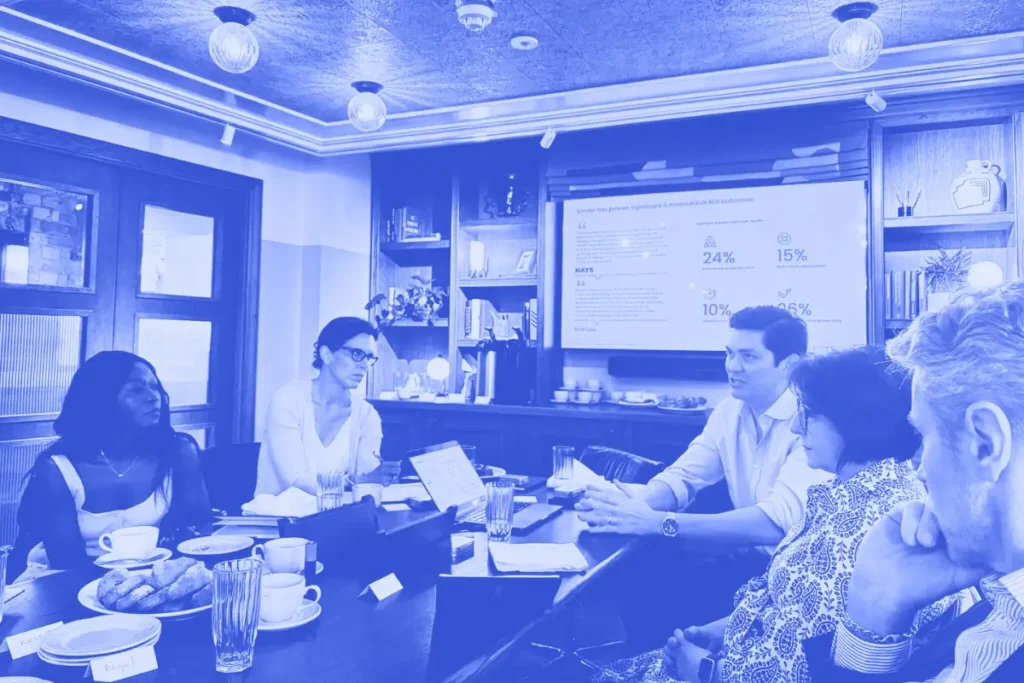A candid look at the challenges facing HR directors and the wellbeing solutions that are actually working.
If you’re reading this, chances are you’re grappling with the same challenges that filled a room of chief people officers and HR directors at a recent roundtable breakfast. Hosted by Sonder in partnership with Craig McCoy and London HR Connection & the HR Connection Group, the discussion focused on health and wellbeing as a driver of business growth and success. With our CEO Craig Cowdrey facilitating, the conversation revealed some frustrating truths: traditional employee support isn’t working, and the cost of inaction is becoming impossible to ignore.
The uncomfortable truth about employee trust
Let’s address what many of us already know but rarely say out loud, our employees don’t trust the support we’re providing. The evidence is sobering. Across organisations represented at the roundtable, utilisation rates for employee assistance programmes hover around 2%, with one 5,000-person workforce generating just 20 calls to their EAP provider over an entire period.
“Our workforce doesn’t trust our current support,” one HR leader stated bluntly. “They won’t even report absence properly.”
Low engagement is certainly one piece of the puzzle, but it’s more a symptom of the fundamental breakdown in the employee-employer relationship around wellbeing. When data breach headlines combine with lingering stigma around mental health support, employees simply aren’t reaching out. Even more concerning, many managers report they “don’t feel qualified to talk about” mental health issues, creating a silence that serves no one.
The result? Employees are struggling in isolation whilst organisations lose money through ineffective wellbeing strategy and preventable absence and turnover.
Download: Why EAPs are failing your workforce report
The boardroom challenge we all face
Every HR director knows the conversation. You present your wellbeing strategy, and the inevitable question comes: “What’s the ROI?” One wellbeing director captured it perfectly: “The board says what is the ROI – it’s very finance driven… It’s difficult to present to the board as they want savings.”
The measurement challenge is real, compounded by fragmented data systems that make it difficult to establish clear correlations. “Everyone uses different systems and what is the truth!?” asked one frustrated leader. Some organisations report taking eight years to establish quality data flows.
Yet the most successful amongst us are finding ways to make the case. “We’re telling better stories with our data,” explained one director. “When paired with narrative—like a case study or personal impact—it helps get board buy-in.”
The key is connecting wellbeing outcomes to business metrics that boards understand: absence rates, retention costs, recruitment expenses, and productivity measures.
Your workforce is changing—are you keeping up?
Today’s workforces span from 18 to 60-year-olds, creating support challenges that many traditional programmes simply can’t address. The generational divide is real. Older managers report that younger staff seem more fragile, whilst younger employees have fundamentally different expectations around flexibility and mental health support.
The needs vary dramatically. Early-career staff require mental health support and career guidance, whilst older employees are managing elderly parents with dementia and dealing with bereavement. “Attracting the younger generation into healthcare. What are we offering the 18-25 year olds to socially consider it?” asked one social care leader.
This isn’t about choosing sides, it’s about recognising that one-size-fits-all approaches no longer work for today’s diverse workforce.
The middle management bottleneck
If you’ve struggled to engage middle managers in wellbeing initiatives, you’re not alone. Nearly every participant identified this as their biggest challenge. “How do you get it across to middle-managers who are living it everyday? This is the hardest stakeholder group,” explained one HR director.
The issue isn’t resistance—it’s capacity. These managers are “in survival mode—dealing with staff, customers, and compliance. They don’t have time to reflect on wellbeing strategies.”
The most successful organisations are addressing this by embedding wellbeing into manager KPIs or using mental health ambassadors to cascade awareness. But the fundamental challenge remains: how do you support the supporters?
What success actually looks like
The good news? Some organisations are cracking the code. The most compelling example came from one large organisation who saw engagement jump from 20 calls across 5,000 staff to “19% engagement after 2 months, 50% of calls accessing counselling, 33% of calls requiring physical health intervention.”
The key differentiator appears to be integrated, accessible support that removes traditional barriers. Real-time intervention is proving particularly valuable; one driver avoided 28 days of unnecessary absence through immediate app-based triage that confirmed a suspected head injury wasn’t serious.
“There’s a direct correlation between using Sonder and reducing absence,” the employer concluded.
The shift from reactive to preventive
The most forward-thinking organisations are fundamentally changing their approach. “We made the link between an EAP and reducing absence – how do we use it to reduce absence and get people back to work place,” explained one transport leader.
The insight is powerful: “Sickness absences are a consequence that the wellbeing strategy is wrong.” Rather than managing absence after it occurs, successful organisations are preventing it through early intervention and comprehensive support.
Sector-specific realities
- Healthcare and social care leaders report extreme stress levels: “Everyone is frazzled – even at the exec level. People are very stressed.” The emotional toll is severe, with specialist counselling teams now required to support frontline staff dealing with trauma and safeguarding issues.
- Transport and logistics organisations face safety-critical challenges where absence directly impacts service delivery. However, they’re also seeing the clearest correlations between wellbeing support and business outcomes.
- Public sector organisations face unique constraints around accountability and budget scrutiny, requiring different approaches to building business cases.
Building your business case
The strongest arguments combine financial impact with human stories. “Sometimes the strongest argument is showing what happens when you don’t invest in people,” noted one participant.
Others are reframing wellbeing as operational necessity rather than nice-to-have. “You don’t need to hard sell if you put the right support into the workforce for them to thrive,” observed a social care leader.
The key is demonstrating that comprehensive wellbeing support isn’t just about doing the right thing, it’s about business sustainability.
The path forward
The roundtable revealed a fundamental shift in thinking. “We’ve all been through grief, burnout, and trauma, even our exec teams. People need care, not just benefits,” summarised one participant.
Another captured the operational reality: “Life is happening and it’s impacting productivity… How do we support them when life happens, and reduce impact on productivity when they get back.”
The consensus was clear: wellbeing is no longer optional. “We needed to think differently about what we do… Our cost did go up as we went from outdated contract to wrap around service but it was all financials tied to tackling absence.”
What this means for you
If you’re feeling the pressure to demonstrate ROI whilst genuinely supporting your workforce, you’re not alone. The challenges are real, but so are the solutions.
Success requires combining accessibility, trust, comprehensive support, and clear business impact measurement. Organisations that get this right are seeing measurable business benefits including reduced absence, improved retention, and enhanced organisational resilience.
The message is clear: in an era of workforce transformation, mental health challenges, and operational pressures, comprehensive wellbeing support isn’t just good for people—it’s essential for business sustainability.
The question isn’t whether you can afford to invest in proper wellbeing support. It’s whether you can afford not to.
How Sonder can help
Sonder’s employee care platform represents the future of workforce health, medical, safety and wellbeing support. Unlike traditional EAPs that struggle with the 2% engagement problem, Sonder boasts an average usage rate of 40% and allows people to take control of their wellbeing on their terms, on their schedule, and on their device.
Our 24/7 support from registered health professionals addresses the trust crisis whilst preventing trips to hospital 25% of the time and to GPs 30% of the time. For HR leaders struggling to demonstrate ROI, Sonder provides leaders with unique anonymised data and insights to get ahead of tomorrow’s wellbeing challenges, today. To discover how Sonder can transform your organisation’s approach to employee wellbeing, book a demo with one of our wellbeing specialists.



